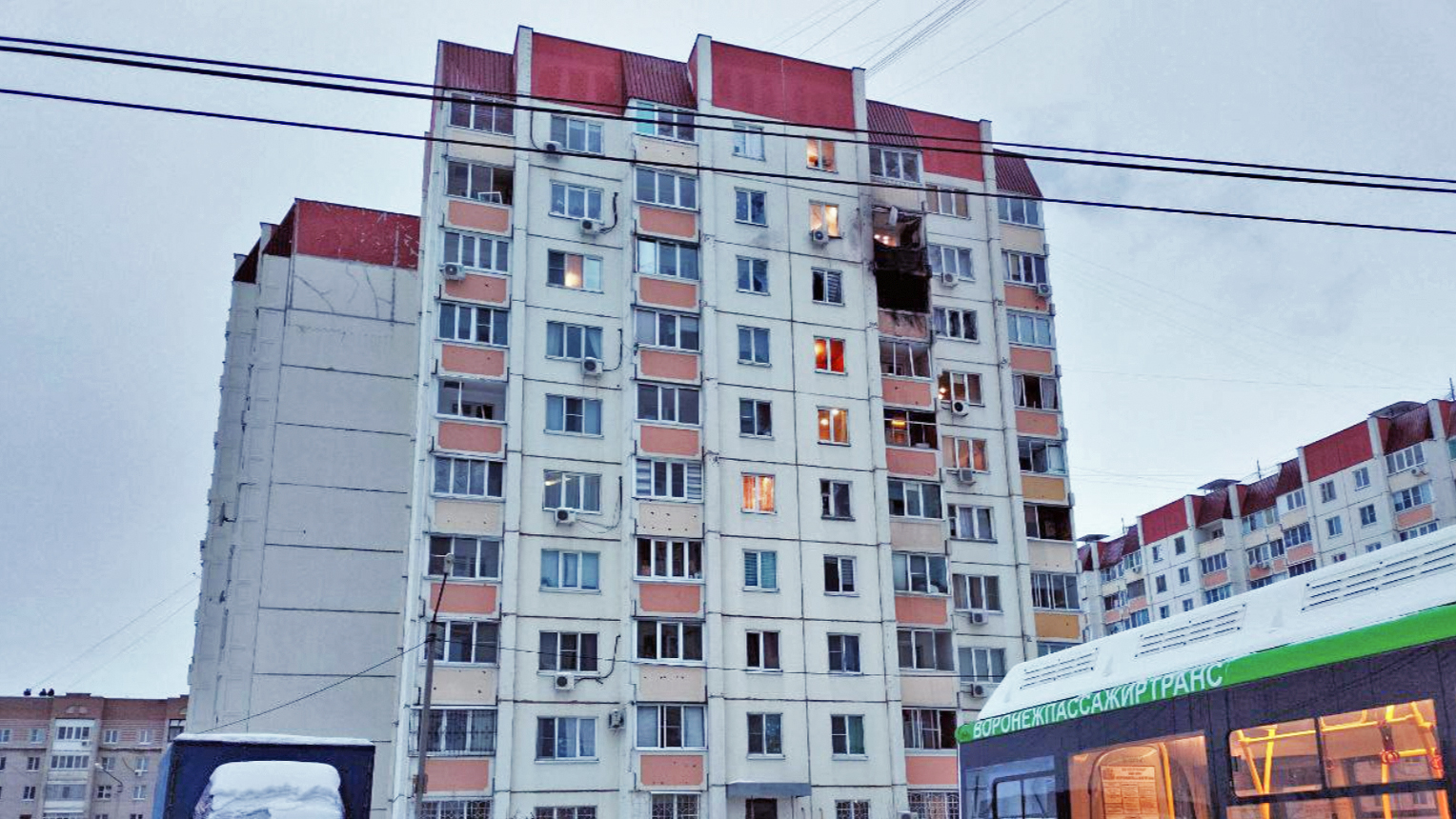Russian authorities declared a state of emergency in the city of Voronezh in southern Russia after what they described as a Ukrainian drone attack overnight. It appears that the airbase close to the city may have been the target, which would suggest that Kyiv is continuing its attacks on Russian airpower, using a variety of means to ensure Russian aircraft are under threat in the air and on the ground.
The Russian news outlet Shot reported that at least 15 explosions were heard near the airbase and some drone debris fell onto a nearby apartment building.
Residents from at least one apartment building in the city were evacuated after the debris started a fire and an explosion blew out windows, according to the mayor of Voronezh, Vadim Kstenin.
The governor of the region of Voronezh, Alexander Gusev, said a girl was injured when drone debris fell onto her apartment building.
According to the Russian Ministry of Defense, five drones were destroyed overnight over the Voronezh region, while another four were brought down in the nearby Belgorod region.
The Russian airbase near the city, Voronezh-Baltimor, is primarily home to Su-34 Fullback fighter-bombers, which have been extensively used in the war in Ukraine. The base is located roughly 100 miles from the Ukrainian border and is seen as a critical installation for Russian military operations in Ukraine.
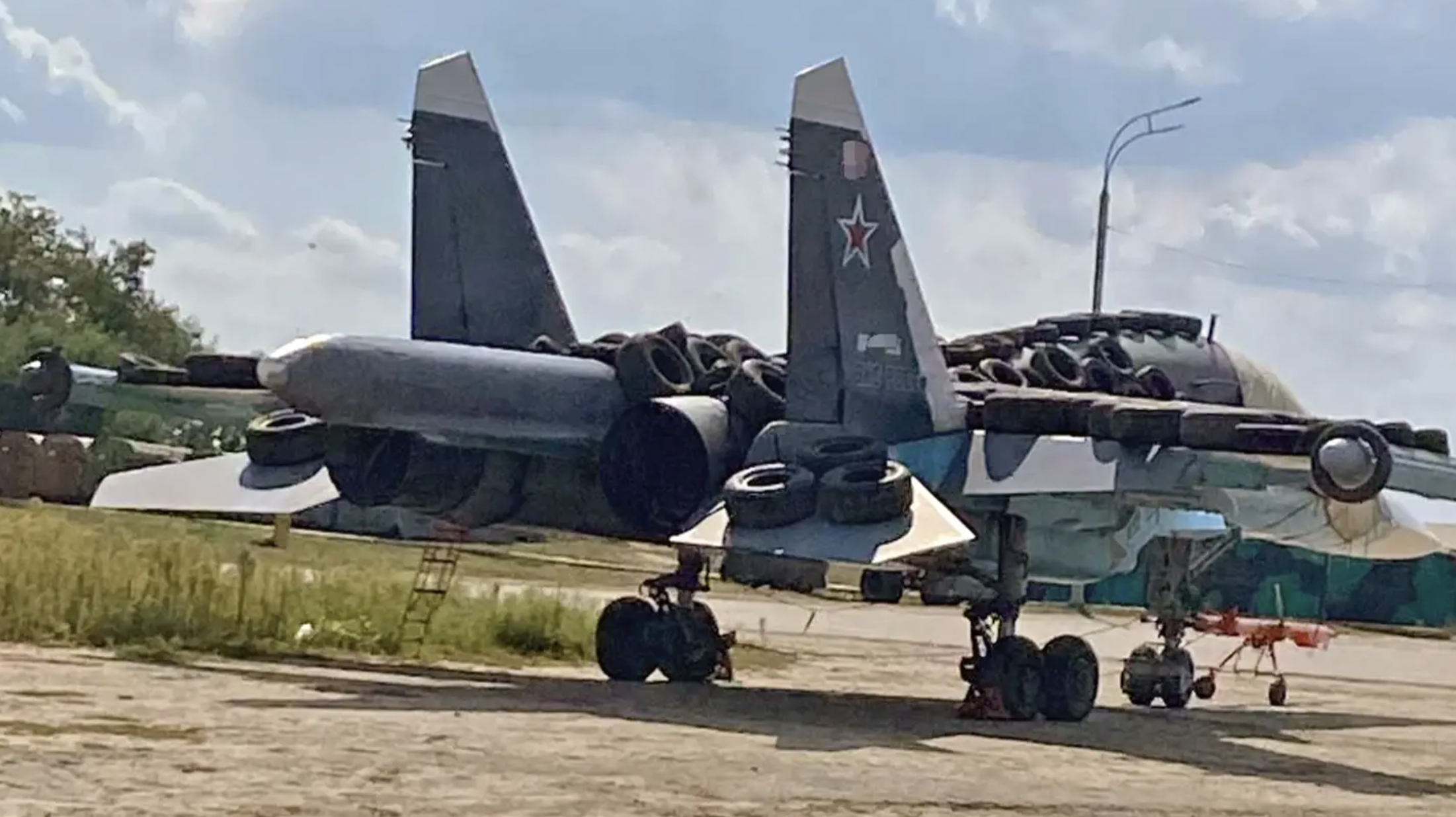
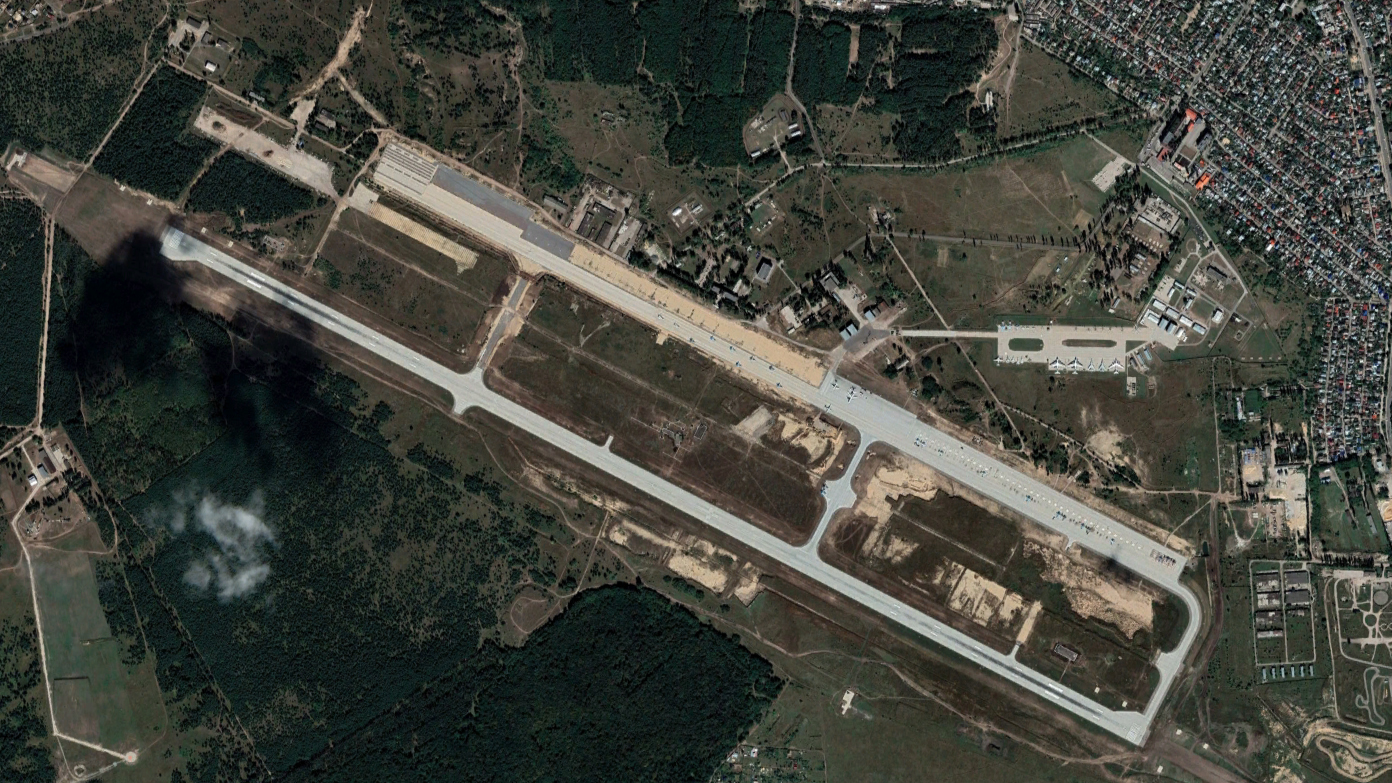
There has been no immediate comment from Ukraine.
As well as continuing Ukrainian efforts to ‘bring the war home’ to Russia, drone strikes like this offer a response to the Kremlin’s ongoing winter campaign of missile and drone strikes against Ukraine.
Before diving into more developments from the conflict in Ukraine, The War Zone readers can review our previous coverage here.
The Latest
As Moscow struggles to fill the ranks of its armed forces fighting in Ukraine, while taking very heavy losses in the process, reports from Kyiv suggest that Russia may be mobilizing between 1,000 and 1,100 recruits each day. These claims come as Ukraine struggles with its own manpower issues, hampered by a mobilization bill that was stalled in parliament earlier this month.
These figures were provided by Vadym Skibitsky, the deputy head of Ukraine’s military intelligence agency, or GUR, in an interview with RBC-Ukraine published yesterday.
Amid well-publicized difficulties in generating manpower for the conflict, Skibitsky says that, as of now, the main driver behind Russian recruitment is the financial incentive.
“Russian prisoners of war frankly admit that they joined the army because they are paid, citing mortgages, families, and so on. And this motive is currently the main one for those people who voluntarily go for mobilization, sign contracts, and fight,” Skibitsky told The Kyiv Independent.
Skibitsky said that the average monthly salary for those fighting in Ukraine is around 220,000-250,000 rubles ($1,700-1,900).
This, in turn, reflects the grinding poverty and poor prospects in many — especially rural — regions of Russia, which appear to provide a disproportionate number of its soldiers fighting in Ukraine.
As of now, the GUR estimates that more than 460,000 Russian soldiers are deployed across occupied Ukrainian territories. There have also been reports of growing numbers of Russian soldiers surrendering in recent weeks, with the bitterly cold weather said to be playing a major part.
The number of deployed Russian troops could grow again soon, Skibitsky warned.
He said that, while Russian mobilization efforts have been scaled back since October–December 2022, the country still has “all the conditions” to increase it “at any time.” There have been suggestions that Russia might launch another mass mobilization after the 2024 Russian presidential election, scheduled for March 17.
“To create a powerful strategic reserve, they really need to mobilize — that’s for sure. Will Putin dare to do this? Not before the election, probably not. And then we’ll see. It is too early to talk about this now,” Skibitsky said.
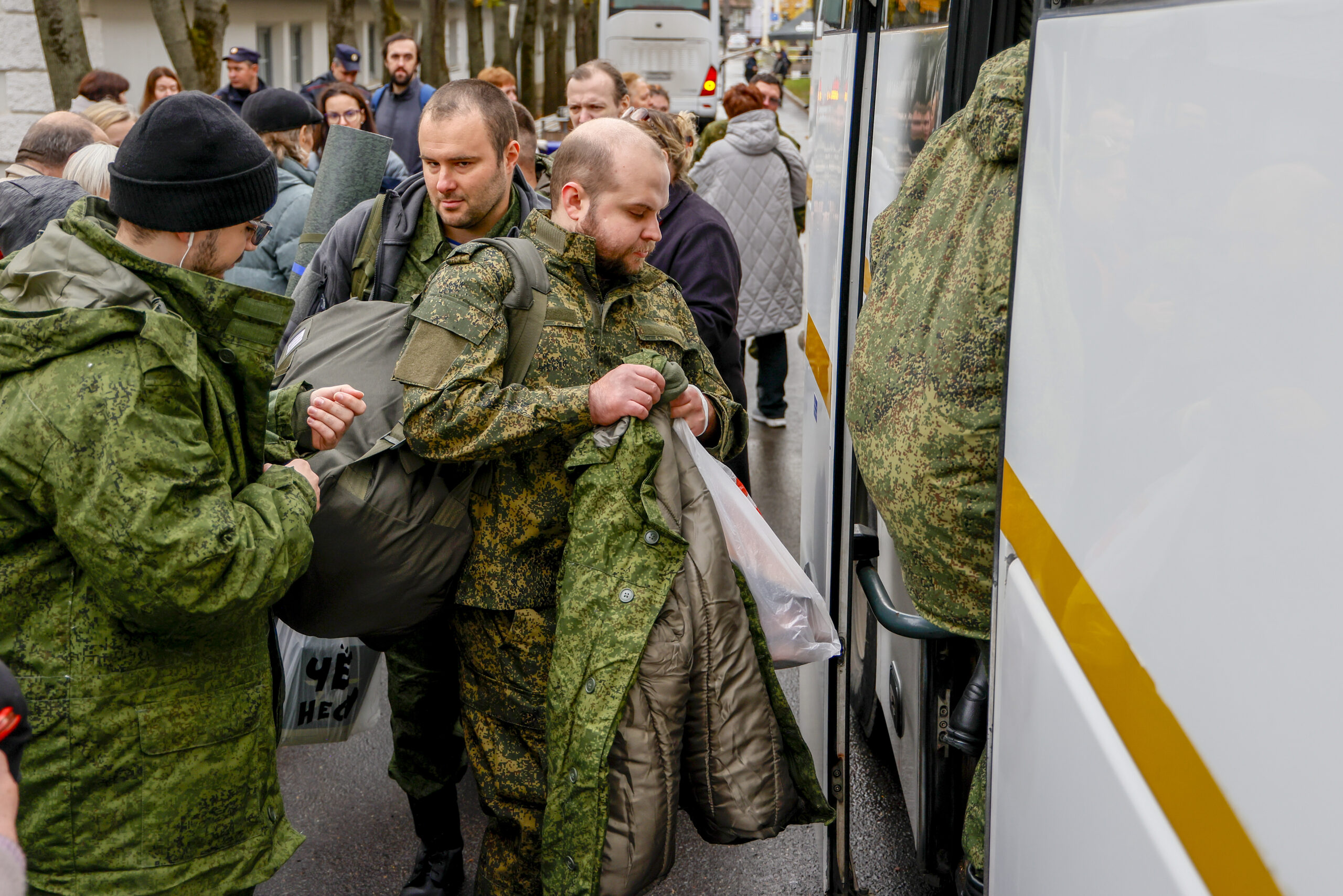
These claims need to be seen in the context of Ukraine’s own mobilization issues.
The War Zone recently reported on how the Ukrainian military’s plans to field more soldiers were dealt a blow after the parliament refused to debate a new bill extending mobilization. The bill had been intended to address shortfalls in the ranks, now felt especially keenly as the Ukrainian counteroffensive, launched in the summer, has made only limited gains.
The bill was kicked back after it was determined that “some provisions directly violate human rights.”
Meanwhile, the Kremlin continues to also call upon foreign fighters to bolster their troop numbers in Ukraine.
This recent video shows a soldier, purported to be from Somalia, who was captured by the Ukrainian Armed Forces. Once again, his rationale for signing up to fight for Russia was allegedly financial.
In an intelligence update yesterday, the U.K. Ministry of Defense said that it doubted a claim by Dmitri Medvedev, Russia’s deputy chair of the security council, that 500,000 people had joined the Russian Armed Forces last year.
Reflecting comments from Skibitsky, the same U.K. Ministry of Defense report also said that it is highly likely that Russian military recruitment to sustain the war has disproportionately drawn from impoverished and rural regional communities.
Writing on X, the U.K. Ministry of Defense said:
“On January 11, 2023, Russian deputy chair of the security council, Dmitri Medvedev, stated that 500,000 people had joined the Russian armed forces in 2023. It is highly likely that this figure has been substantially inflated.”
“In efforts to meet recruitment targets, the Russian military has since April 2023 allowed school leavers to sign contracts with the Russian Army. Recent data published by Mediazona and the BBC Russian service suggests that at least five Russians born in 2005 have died in the conflict.”
Photos showing the Russian Il-22 Coot-B special missions aircraft that reportedly came under fire over the Sea of Azov on Sunday have now appeared on social media. You can read our full report of the incident, in which an A-50 Mainstay airborne early warning aircraft was reportedly also shot down, here.
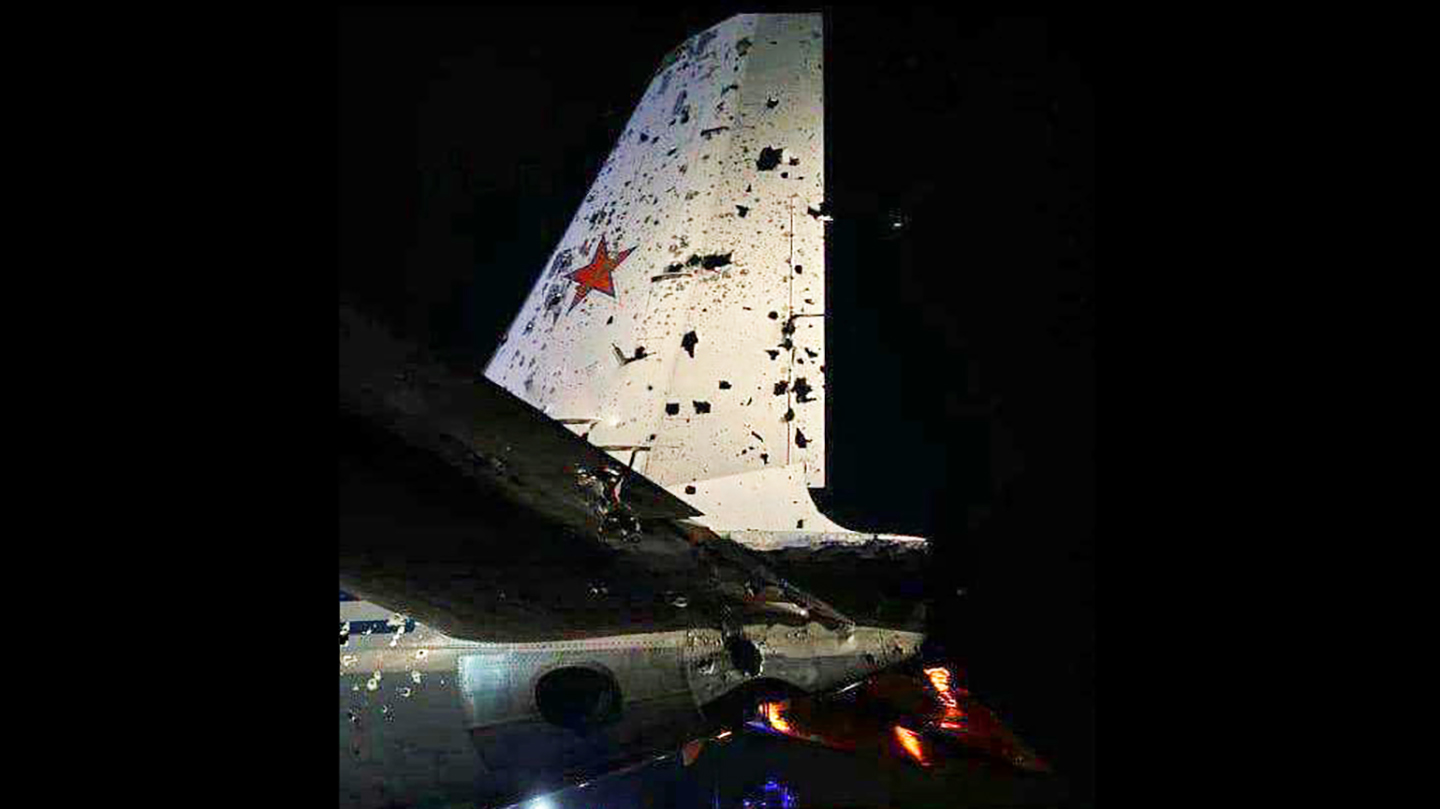
The first photo to appear, as seen above, seems to have been originally posted to the Telegram messaging app by the Russian Fighterbomber channel. It shows the tail and rear fuselage of an Il-22, at night, on an unidentified airbase. The tailfin and rear fuselage are heavily pockmarked with impacts that look very much like those associated with an explosive-fragmentation warhead, of the kind used by many surface-to-air missiles and air-to-air missiles. It appears that the prominent fairing atop the tailfin was torn off in the incident.
The Il-22 reportedly made an emergency landing in Anapa, on the northern coast of the Black Sea near the Sea of Azov.
Subsequently, at least one additional photo showing a slightly different view of the same aircraft emerged.
At least one version of the first photo doesn’t have the aircraft’s registration edited out, revealing it as RF-95678, which is an Il-22M11 version. This is a radio-relay aircraft, as opposed to the Il-22 airborne command post from which it was derived. Most Il-22M11 aircraft have been upgraded to Il-22M11-RT Sokol standard.
While the Il-22 may well never fly again, judging by the level of damage seen in the photo, what became of its crew is unclear. These aircraft typically operate with a flight crew of five (pilot, co-pilot, navigator, flight engineer, and communications operator) as well as at least six mission crew.
Published communications between the stricken Il-22 and the Anapa airport dispatcher include requests for an evacuation, as well as an ambulance and a fire truck.
So far, there have been no official Russian explanations for what happened to the Il-22, or the A-50 that has also been claimed as destroyed by Ukraine, apparently shot down.
As for the A-50, the Fighterbomber channel claims that the radar plane fell victim to a Russian air defense system. This led to the death of 11 or 12 crew, the same source states.
Fighterbomber also raises the possibility of a third Russian aircraft being attacked. The channel points to rumors that a Su-34 strike aircraft “allegedly evaded an incoming missile around the same time the Il-22M11 and A-50 were hit. In a report to the dispatcher, the Su-34 pilot informed about evading the missile.”
No other details of the supposed Ukrainian operation have been released, although there has been plenty of speculation that a U.S.-made Patriot air defense system, moved closer to the front lines than Russia likely expected, may have been responsible.
At this stage, we simply don’t know for sure, but if this was a carefully planned Ukrainian operation, it could have major implications as to how the Russian Aerospace Forces can operate, even when a hundred or so miles from the front. You can read more about this here.
On the battlefield, Russia hopes to make gains in the southern Kherson and Zaporizhzhia regions, according to a high-ranking Ukrainian commander.
Col. Gen. Oleksandr Syrskyi, the second-in-command in the Ukrainian Armed Forces, told Reuters that Ukrainian troops are now launching smaller counterattacks in these regions as part of a strategy of “active defense.” Essentially, keeping the enemy tied down, while looking to exploit opportunities to strike as and when they present themselves.
With the full-scale invasion approaching its second anniversary, Syrskyi said that Russia was looking to seize the initiative once again in the south.
Smaller-scaler engagements in these regions are also apparently being driven by a general need to conserve ammunition and men. Syrskyi assesses that Russia has also learned lessons from the fighting so far and is now less likely to commit troops in large numbers. “Offensives at the level of a battalion are a major rarity,” Syrskyi said and suggested that the wider use of drones was also behind this change in tactic.
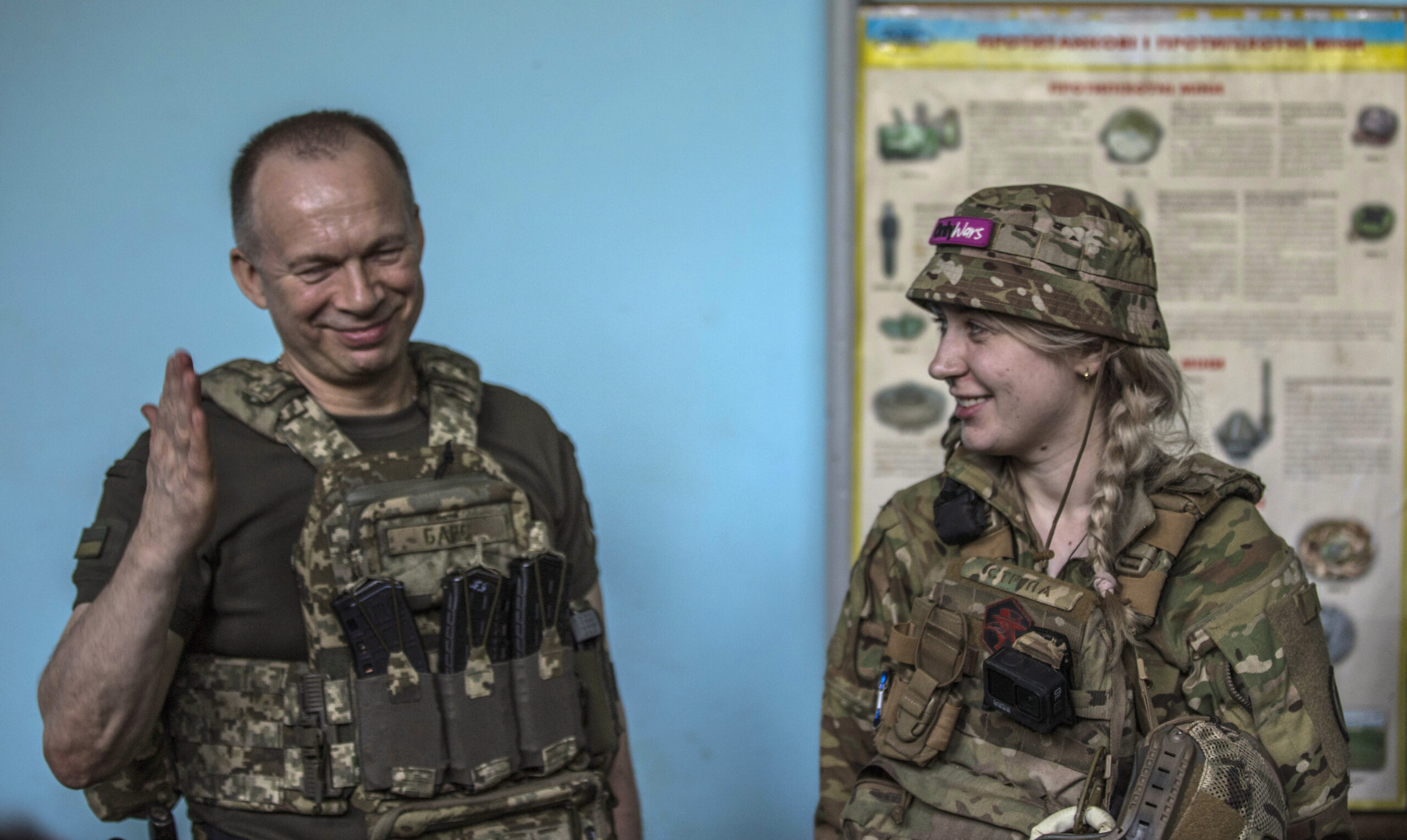
There has been a spate of recent accounts of Ukrainian U.S.-supplied M2 Bradley infantry fighting vehicles excelling in combat against Russian tanks, in encounters that would normally be expected to be tilted in favor of the latter.
One of the latest examples captured on video shows a T-90M, the most modern Russian tank fielded in Ukraine, getting bettered by a Bradley, reportedly near Avdiivka.
Another video of a Bradley in action now, again displaying the impressive firepower offered by its 25mm Bushmaster cannon, as it engages Russian positions.
The United Kingdom is ramping up its production capacity for much-needed 155mm artillery ammunition, by a factor of eight, after delivering over 300,000 of these munitions to Ukraine.
James Cartlidge, a minister of state in the U.K. Ministry of Defense, told parliament:
“The Ministry of Defense (MOD) placed an order in June 2023 with BAE Systems to provide an eight-fold increase in production capability of 155mm shells. The MOD contract is for significant initial quantities of 155mm shells which will reinstate and build sovereign capability and stockpiles. In respect of artillery ammunition being provided to Ukraine, since the start of the conflict, the UK has donated over 300,000 rounds of artillery ammunition — including 155mm and former Soviet Union calibers.”
In other U.K.-related news, Minister of Defense Grant Shapps has praised Ukraine for its efforts in the war so far, saying:
“Valiant Ukrainian warriors have been incredible, successful in pushing back invading Russian forces, retaking 50 percent of the territory stolen by Russia, opening up a maritime passage in the Black Sea, but the West must not let them down.”
As well as doubling down on British support for Kyiv, Shapps also issued a warning that the country should prepare for future wars involving China, Russia, Iran, and North Korea in the next five years.
Yet another Russian UAZ-452 4×4 off-road van, better known as a Bukhanka, has fallen victim to an attack by a Ukrainian first-person view (FPV) drone. The footage in question shows the harrowing scene from inside the van, including immediately after the explosive payload detonates, injuring at least one of the occupants, whose leg is seen bleeding profusely.
Purportedly filmed by a Russian soldier, the next video shows the fiery demise of what is said to be a truck loaded with ammunition. It seems that when the soldier began filming the blaze, they weren’t expecting quite such a dramatic conflagration.
The effort to get F-16 fighters into Ukrainian hands has taken another step forward with the arrival of the first Norwegian Vipers in Denmark, to support the pilot training effort there.
Norway is sending two F-16s to Denmark, having already sent 10 instructors there, to help train Ukrainian pilots. Norway previously replaced all its F-16s with F-35As.
The latest air-launched munition type to have been adapted for the Russian UMPK guided glide bomb kit appears to be the 1,102-pound ODAB-500OF. The ODAB (Obyomno-Detoniruyushchaya Aviatsionnaya Bomba) series are fuel-air explosive (or thermobaric) bombs to defeat soft-skinned materiel and personnel, as well as for clearing minefields. Previously, UMPK kits have also been mated with cluster bombs and very heavy 6,614-pound FAB-3000 bomb bodies.
There are yet more signs of the burgeoning military relationship between Russia and North Korea.
In an announcement yesterday, the Kremlin said Russia was developing relations with “our partner” North Korea in all areas. This follows from agreements made in September last year when the leaders of the two countries met at a Russian space launch center.
“North Korea is our closest neighbor and partner, with whom we are developing and intend to further develop partnerships in all areas,” Kremlin spokesperson Dmitry Peskov said as North Korea’s foreign minister, Choe Son Hui, began a visit to Moscow yesterday, according to Reuters.
Recent figures provided by Ukraine claim that North Korea already provided Russia with two million 122mm and 152mm artillery last year alone.
Since the meeting between Vladimir Putin and Kim Jong-un at the Vostochny space launch facility in Russia’s far east, Pyongyang has continued to provide Russia with munitions for the war in Ukraine, not only with much-needed artillery ammunition but, more recently, ballistic missiles.
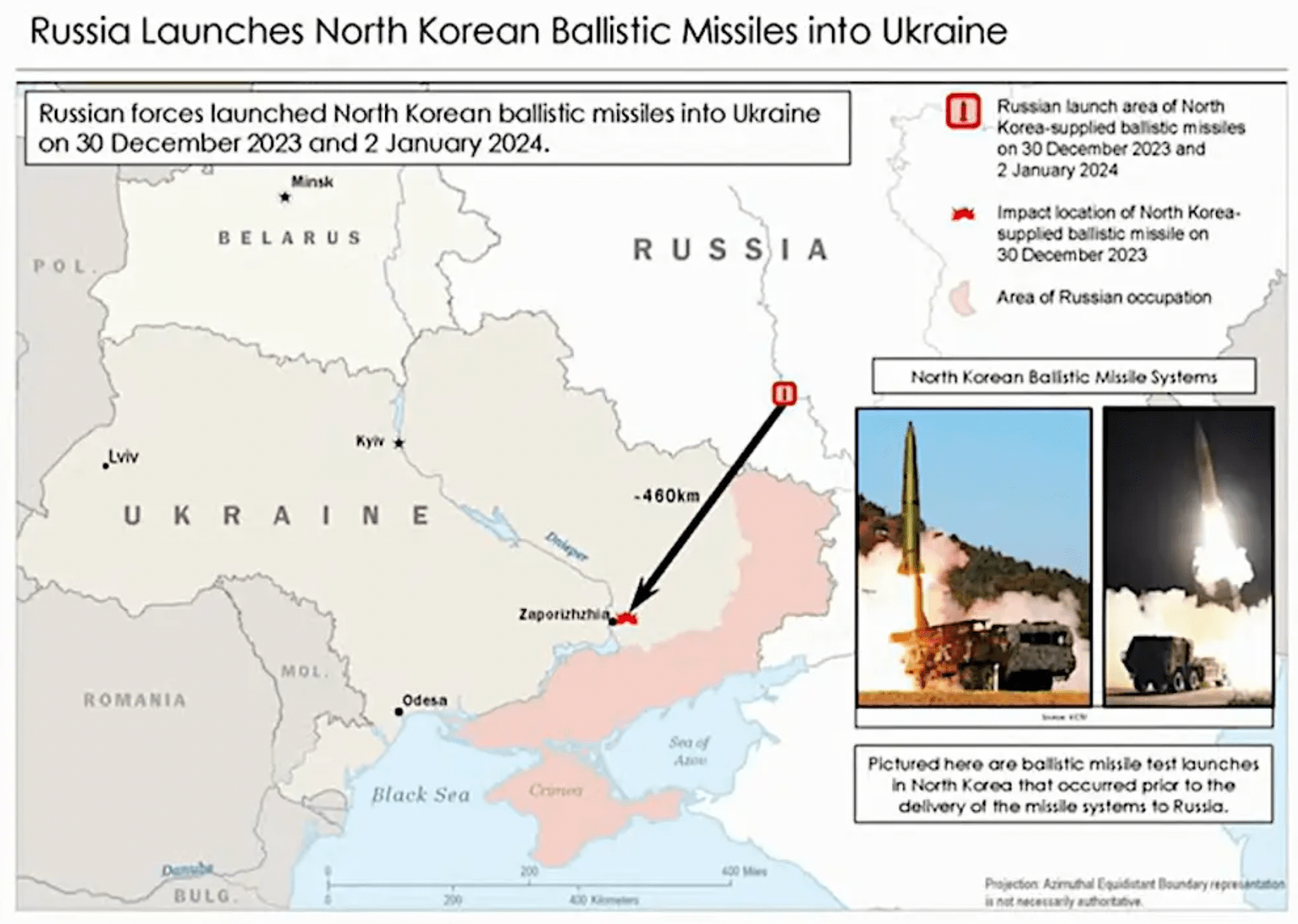
In return, it’s expected that Russia will provide North Korea with technology to help build satellites, which will very likely also help it as it continues to develop new ballistic missiles in the face of U.N.-led sanctions.
Russia claims to have destroyed three Ukraine-launched Tochka-U (SS-21 Scarab) short-range ballistic missiles (SRBMs) over southwest Russia’s Kursk region early on Monday.
Writing on Telegram, the Russian Ministry of Defense said that undisclosed Russian air defense systems brought down the missiles, a type that has been used fairly sparingly by the Ukrainian Armed Forces in the past.
The Russian Ministry of Defense did not say whether there was any damage or injuries due to the attack.
A wide range of vehicle decoys have cropped up in the war so far, some more faithfully replicating the originals than others.
This Russian decoy for the Buk-M2 self-propelled surface-to-air missile system is a more accurate replica than many we have seen so far, despite being inflatable.
The latest Ukrainian drone initiative — known as “People’s Drone” — is calling upon civilians to build FPV drones in their own homes. The seven-inch drones can be assembled at home by civilians who have taken a free engineering course and then can then be fielded by the military, which is making significant use of them for both surveillance and attack.
In recent months there have been repeated reports warning that Russia’s output of FPV drones far outstrips that of Ukraine, which could have serious consequences on the battlefield.
Among the latest videos showing FPV drones in action against armor is this one, also reportedly from the Avdiivka area. In this case, the FPV strike by the Ukrainian “Alpha” special forces group removes the turret (and more) from a Russian T-80 tank.
In this still photo, a Ukrainian FPV drone captures the last moments before it strikes a group of Russian soldiers riding atop an armored vehicle. The electrical detonator for the munition is seen in the form of a wire loop projecting out in front of it, immediately ahead of the camera.
Russia has sentenced a 20-year-old student to five years imprisonment, after alleging that he worked on sabotage attacks on behalf of the Ukrainian special services.
Local authorities said that the accused was planning to launch attacks on undisclosed military bases, while the branch of the Federal Security Service (FSB) in the central Russian city of Kurgan said he was detained on suspicion of working with a foreign state, according to AFP.
“The defendant planned to commit sabotage at military and social infrastructure facilities,” the statement, distributed to Russian news agencies, said.
Sabotage within Russia, especially against military facilities, has been reported on multiple occasions since the launch of the full-scale invasion.
Earlier this month, a Russian Su-34 Fullback fighter-bomber was apparently set on fire by an act of sabotage, as it sat at its airbase, deep inside Russia.
According to the FSB, the culprit was a 16-year-old Chechen schoolboy from Dagestan. Prosecutors want to jail him for 20 years, claiming that he undertook the action on behalf of the Ukrainian Ministry of Defense’s Main Directorate of Intelligence (GUR).
Evidence has surfaced of parts from a Kinzhal air-launched ballistic missile landing in Russia. Residents of the Ryazan region found what appears to be the protective fin cap from the rear end of the Kinzhal, part of the missile that is ejected as part of its normal launch process. More surprising is the fact that one of those locals loaded the missile part into the rear of their car, for onward transport, destination unknown.
There have been recent reports on the effectiveness of Russian electronic warfare jamming in the conflict, especially when employed against the GPS-aided navigation systems used by precision munitions.
Now, Ukraine is reportedly also benefiting from similar technologies. According to Ukrainian Air Force spokesman Yuriy Ignat, more than 20 Russian missiles were prevented from reaching their targets by Ukrainian jamming during one series of strikes on January 13.
The use of the 2S1 Gvozdika 122mm self-propelled howitzer by both sides in the conflict has been widely documented. Nonetheless, it is interesting to see how Ukrainian troops are using underground shelters dug into the earth to protect these weapons when they are not in action. The provision of shelters of this kind is likely driven not only by the threat of counter-battery strikes but also by the growing prevalence of explosives-laden drones on the battlefield.
That’s it for now. We’ll update this story when there’s more news to report about Ukraine.
Contact the author: thomas@thedrive.com
